-
Paper Information
- Paper Submission
-
Journal Information
- About This Journal
- Editorial Board
- Current Issue
- Archive
- Author Guidelines
- Contact Us
Geosciences
p-ISSN: 2163-1697 e-ISSN: 2163-1719
2019; 9(1): 18-26
doi:10.5923/j.geo.20190901.03

Paleoenvironmental Reconstruction of an Onshore Field, Coastal Swamp Depobelt, Niger Delta
Okoli Emeka Austin1, Acra Jones Edward2, Ehirim Chukwuemeka Ngozi3, Adewale Dosunmu, Okechukwu Ebuka Agbasi3
1Federal University of Technology, Owerri, Nigeria
2University of Port Harcourt, Nigeria
3Micheal Okpara University of Agriculture, Umudike, Nigeria
Correspondence to: Okechukwu Ebuka Agbasi, Micheal Okpara University of Agriculture, Umudike, Nigeria.
| Email: |  |
Copyright © 2019 The Author(s). Published by Scientific & Academic Publishing.
This work is licensed under the Creative Commons Attribution International License (CC BY).
http://creativecommons.org/licenses/by/4.0/

Three (3) wells from “Sigma Field” and biostratigraphic data of Sigma-25, coastal Swamp Depobelt, Niger Delta were integrated to carry out a sequence stratigraphic analysis of depositional systems in the field and further develop conceptual models in areas not penetrated by wells. The analysis revealed one (1) 3rd order Maximum Flooding Surfaces (MFS) dated 11.5 Ma MFS delineated. The 11.5Ma MFS was identified from bio-stratigraphic analysis of micro-floral and palynological zonation provided for Sigma-25 which dated sediments that penetrated the F9500 zone and P784-750 zone of the Serravallian in the Middle Miocene age on the Niger Delta chronostratigraphic chart. Other candidate Maximum Flooding surfaces dated 10.4 Ma MFS and 9.5 Ma MFS respectively were identified on Sigma-25 using lowest resistivity value and widest separation between density and neutron logs. Four 3rd order depositional sequences bounded by four erosional surfaces interpreted as Sequence Boundaries and dated 12.1, 10.6, 10.35, and 8.5Ma were also delineated. A Transgressive Surface of Erosion (TSE) that mark the onset of marine flooding and turnarounds from progradational facies to retrogradational facies during sequence build-up was delineated in the fourth depositional sequence. The delineated sequences comprised Lowstand Systems Tracts, Transgressive Systems Tracts and High stand Systems Tracts and predominantly reflected a regressive phase. The Low stand Systems Tract (LST) is representative of a delta front process specifically the Distributary Channel fill sediments. Transgressive Systems Tract (TST) consists of retrogradational marine shales deposited during high relative sea levels and when accommodation space was higher than rate of sediment influx. High stand Systems Tracts (HST) consisted of Distributary Mouth bars sands in the first and second depositional sequence displaying generally an aggradational stacking pattern and Fluvial sands in third and fourth depositional sequence displaying generally an aggradational stacking pattern. The depositional model in the field was inferred from Conceptual models generated with the available wells in both strike and dip direction. Sigma field showed a transition from a deltaic environment to a fluvial environment as sea level generally shows a relative fall going upwards across the well section. The sands of LST and HST show good reservoir qualities while the shales of the TSTs could form potential reservoir seals and show source rock potential. The above recognized sequences were deposited within the Non-marine – Inner Neritic paleo-water depths.
Keywords: Unconformities, Progradation, Retrogradational, Aggradational, Paleoenvironments and Reservoir
Cite this paper: Okoli Emeka Austin, Acra Jones Edward, Ehirim Chukwuemeka Ngozi, Adewale Dosunmu, Okechukwu Ebuka Agbasi, Paleoenvironmental Reconstruction of an Onshore Field, Coastal Swamp Depobelt, Niger Delta, Geosciences, Vol. 9 No. 1, 2019, pp. 18-26. doi: 10.5923/j.geo.20190901.03.
1. Introduction
- Sequence stratigraphic analysis of these successions define key stratal surfaces at abrupt dislocations of system tracts to delineate broad-scale facies trends formed by along-basin shifts in depositional environments and changes in preservation within system tracts (Vail et al., 1977; Posamentier et al., 1988; Postma, 1995). Higher-frequency progradation and transgression of deltaic systems tracts has been related to both random autocyclic channel avulsion and associated delta lobe switching, and to allocyclic processes like sea-level fluctuations and climate changes (Thorne and Swift, 1991). The internal architecture of deltaic successions that prograde onto mobile shale substrates can be significantly complicated by structural collapse of the delta front. Despite extensive literature on large delta deposits, little attention has been focused on influence of mobile substrates on the resulting sequence stratigraphy.The Niger Delta has a distinctive structural and stratigraphic zonation. Regional and counter-regional growth faults, developed in an outer-shelf and upper-slope setting, are linked via a translational zone containing shale diapirs to a contractional zone defined by a fold-thrust belt developed in a toe-of-slope setting (Hooper, 2002). Damuth (1994) considered Neogene gravity tectonics and depositional processes on the modern deep Niger Delta continental margin. He recognized three regional structural styles; (1) an upper extensional zone of listric growth faults beneath the outer shelf, (2) a translational zone of diapirs and shale ridges beneath the upper slope; and (3) a lower compressional zone of imbricate thrust structures (toe thrusts) beneath the lower slope and rise. He suggested these areas with different structural style are linked together on a regional scale and that these variations in style suggest that large portions of this thick sediment prism are slowly moving downslope by gravity collapse. Cohen and Ken McClay (1994) discussed sedimentation and shale tectonics of the northwestern Niger Delta front. Morgan (2004) examined relationships between mobile shale structure and channel formation above the compressional toe of Niger Delta and highlighted the importance of transfer zones within the toe thrust belt as a control on the underlying structural framework. Adeogba et al. (2005) discussed transient fan architecture and depositional controls from near-surface 3-D seismic data of Niger Delta continental slope. Corredor et al. (2005) related structural styles in the deep-water fold and thrust belts of the Niger Delta and concluded that there are two complex, imbricate fold and thrust belt systems (the inner and outer fold and thrust belts) that are the product of contraction caused by gravity-driven extension on the shelf. Okoli et al., (2018a) explained the role of deformation in controlling depositional patterns in the south-central Niger Delta, their work was however focused mainly at the compressional toe of the delta, and they concluded that structural elements are the primary control of accommodation changes on the slope and toe of the delta.Other examples of deltaic systems that rapidly prograded onto mobile substrates include: the Baram delta, offshore Brunei (Rensbergen et al., 1999), Caspian Sea (Khalivov and Kerimov 1983), and Alboran Sea (Morley 1992). Daily (1976) synthesized relationships between progradation, subsidence, basal under compacted shale wedge, growth faulting, shale diapirism and overthrusting within the Mississippi, Niger and Mackenzie Delta systems. They established that shale diapirs and associated growth faults exerted an important influence on large- and small-scale bedding geometries and facies changes of syntectonic shallow- marine, shoreface and tidal strata for the area. Edwards (2000) reviewed the origin and significance of failed shelf margins of Tertiary northern Gulf of Mexico basin and recognized the role of slumping in forming unconformities of regional extent along retrograde failed shelf margins. Rensbergen and Morley (2000) discussed a 3D Seismic study of a shale expulsion syncline at the base of the Champion delta, offshore Brunei and its implications for the early structural evolution of large delta systems.
 | Figure 1. Niger Delta Sequence Stratigraphic Column |
2. Materials and Methods
- Materials provided for this study include seismic volume in SEG-Y format, geophysical well logs, base map and check shot data from Sigma field. The standard micropaleontological sample preparation method involving sample disaggregation and washing through a 63-micron mesh sieve, drying and picking of the foraminifera and accessory fauna were used (Armstrong and Brasier, 2005; Ukpong et al, 2017). The foraminiferal statistical data was imputed into Strata- Bugs (Biostratigraphy Data Management software) for data processing and integration with the well logs data. Seismic analysis was achieved on Petrel window (version 2016). The workflow plan is shown in figure 2.
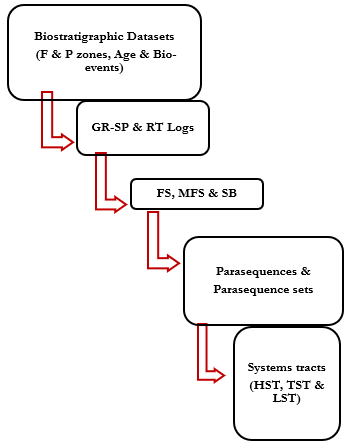 | Figure 2. Sequence stratigraphic analysis Workflow |
3. Results and Discussion
- The following methods were adopted for the sequence stratigraphic interpretation:Foraminiferal biozonation and Paleo-bathymetric interpretation, Paleo-bathymetric interpretation shows that the environment ranged from non-marine through shallow inner neritic, inner neritic, middle neritic and outer neritic (Figure 1).Geophysical well log interpretation (gamma-ray and resistivity logs) was confirmed from the lithologic information. Lithostratigraphic analyses were based on detailed description gamma ray log signatures, which the result shows an alternation of sand and shale in a progressive pattern. The well log characteristics were used to delineate the different systems tracts (Figure 3). Sequence boundaries were delineated at points of inflection from progradation to retrogradation of parasequences in shallowing upward sand sections, and at the fluctuation points of lowstand systems tract. Points of high gamma ray and lowest resistivity log response were used for the identification of maximum flooding surfaces (Onyekuru et al., 2012).
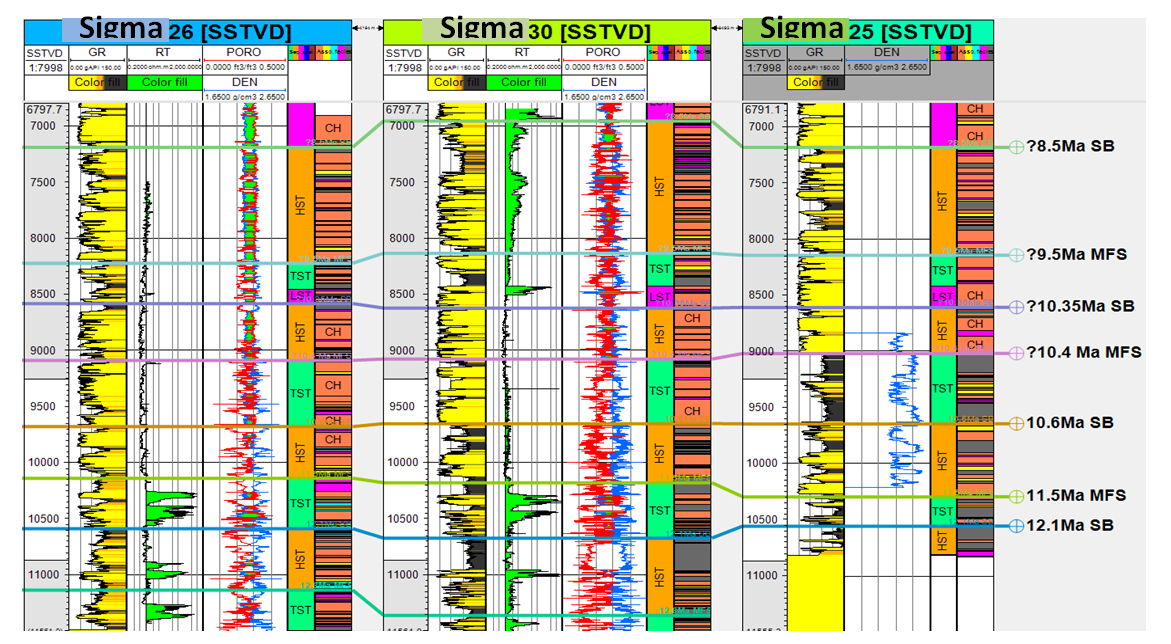 | Figure 3. Geophysical well log interpretation |
|
 | Figure 5. Conceptual depositional environment model of Sigma-26 and 30 in strike direction as at 11.5 Ma MFS |
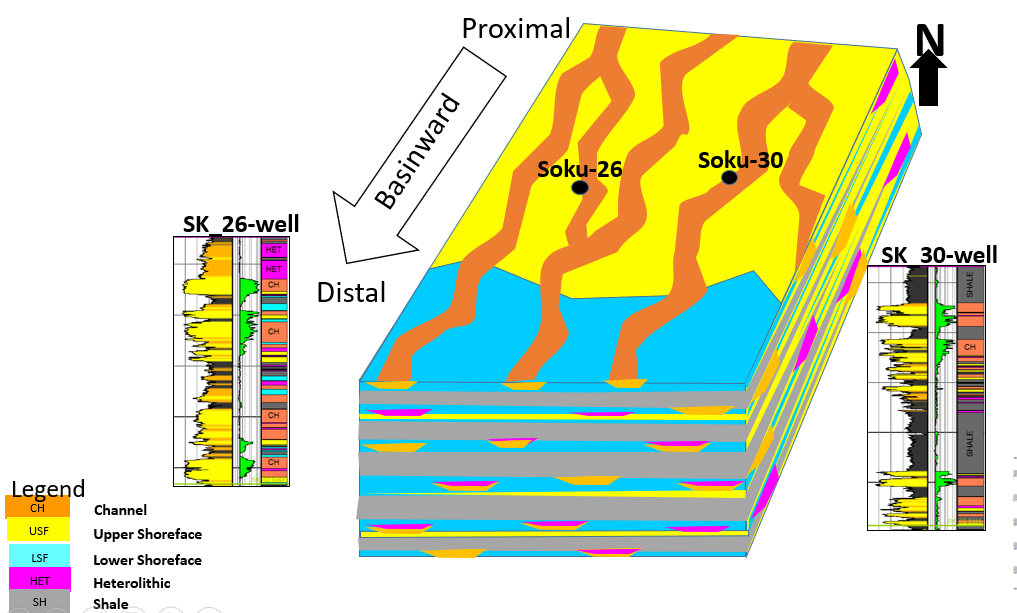 | Figure 6. Conceptual depositional environment model as at 11.5 Ma MFS |
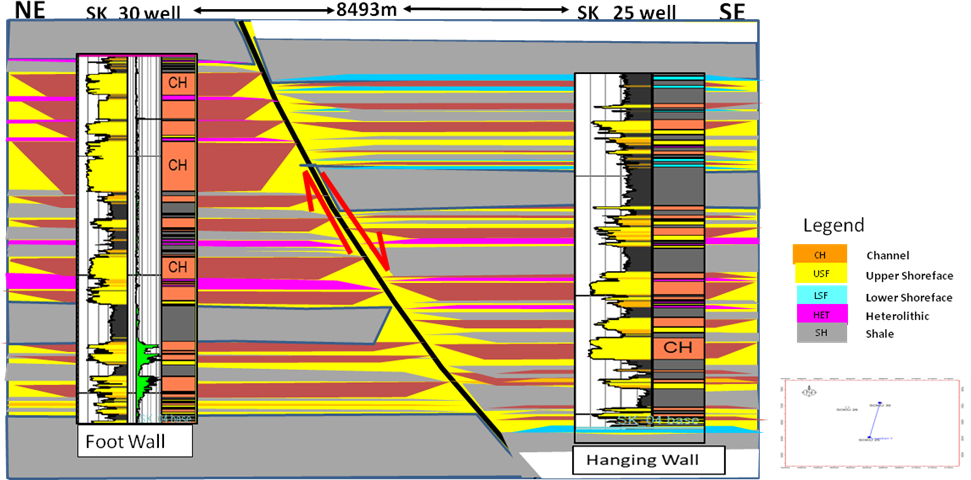 | Figure 7. Conceptual depositional environment model of Sigma-25 and 30 in dip direction as at 10.4 Ma MFS |
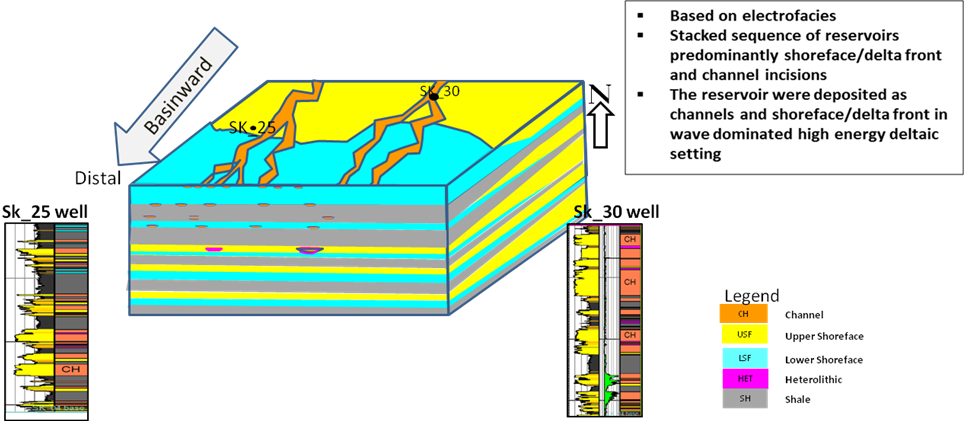 | Figure 8. Conceptual depositional environment model in dip direction as at 10.4 Ma MFS |
 | Figure 9. Conceptual depositional environment model as at 10.4 Ma MFS |
 | Figure 10. Conceptual depositional environment model as at 10.4 Ma MFS |
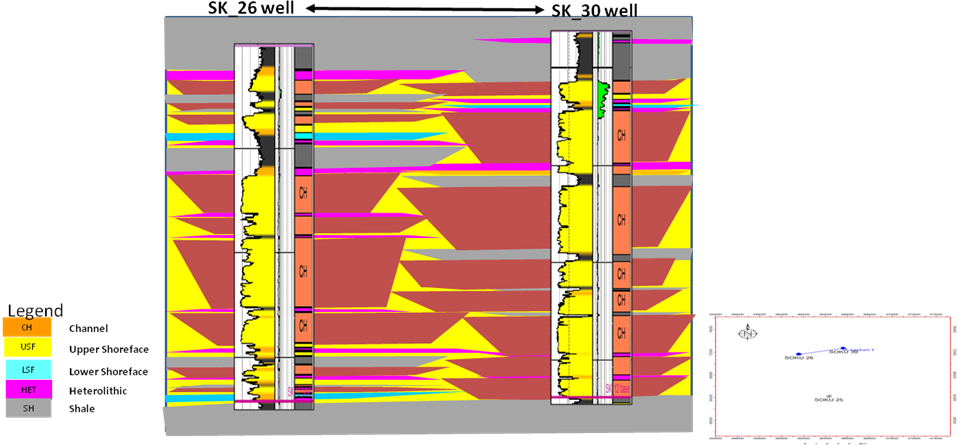 | Figure 11. Conceptual depositional environment model as at 9.5 Ma MFS |
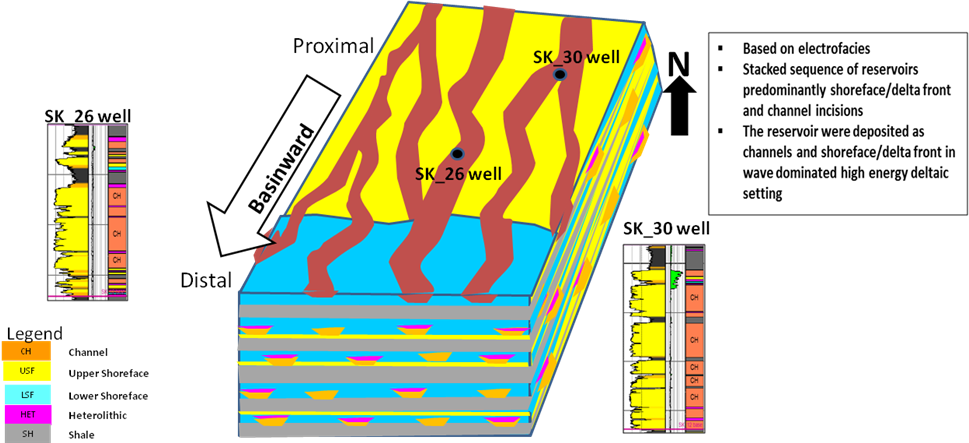 | Figure 12. Conceptual depositional environment model as at 9.5 Ma MFS |
4. Conclusions
- One MFS which is the 11.5Ma MFS was discovered from bio-stratigraphic analysis which corresponded to Cassidulina 7 shale marker and two other candidate MFSs which are the 10.4 and 9.5 Ma were inferred from use of well logs in identifying MFS. Four depositional sequences were identified with the first and second depositional sequence culminating into 12.1Ma SB and 10.6Ma SB respectively. As we go upwards from the bottom of the well, the stacking pattern depicts delta front depositional environment as shown in our conceptual model interpretations. The third and fourth depositional sequence terminating at 10.35 Ma SB and 8.5Ma SB respectively characterized high energy fluvial environment as we see from the clean sands deposited within the interval. The sands within the depositional sequence show good reservoirs properties and the thick shales within the fourth and depositional sequence have source rock potentials.
 Abstract
Abstract Reference
Reference Full-Text PDF
Full-Text PDF Full-text HTML
Full-text HTML